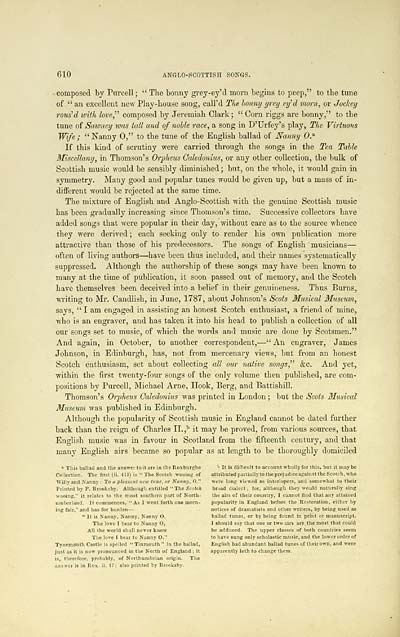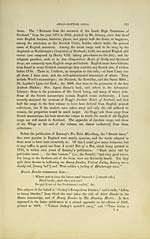Glen Collection of printed music > Printed text > Popular music of the olden time > Volume 2
(234) Page 610
Download files
Complete book:
Individual page:
Thumbnail gallery: Grid view | List view

610 ANGLO-SCOTTISH SONGS.
composed by Purcell; " The bonny grey-ey'd morn begins to peep," to the tune
of " an excellent new Play-house song, call'd The bonny grey eijd morn, or Jockey
rous'd with love" composed by Jeremiah Clark ; " Corn riggs are bonny," to the
tune of Sawney was tall and of nolle race, a song in D'Urfey's play, The Virtuous
Wife; " Nanny 0," to the tune of the English ballad of Nanny 0. a
If this kind of scrutiny were carried through the songs in the Tea Table
Miscellany, in Thomson's Orpheus Qaledonius, or any other collection, the bulk of
Scottish music would be sensibly diminished ; but, on the whole, it would gain in
symmetry. Many good and papular tunes would be given up, but a mass of in-
different would be rejected at the same time.
The mixture of English and Anglo-Scottish with the genuine Scottish music
has been gradually increasing since Thomson's time. Successive collectors have
added songs that were popular in their day, without care as to the source whence
they were derived ; each seeking only to render his own publication more
attractive than those of his predecessors. The songs of English musicians —
often of living authors — have been thus included, and their names systematically
suppressed. Although the authorship of these songs may have been known to
many at the time of publication, it soon passed out of memory, and the Scotch
have themselves been deceived into a belief in their genuineness. Thus Burns,
writing to Mr. Candlish, in June, 1787, about Johnson's Scots Musical Museum,
says, " I am engaged in assisting an honest Scotch enthusiast, a friend of mine,
who is an engraver, and has taken it into his head to publish a collection of all
our songs set to music, of which the words and music are done by Scotsmen."
And again, in October, to another correspondent, — " An engraver, James
Johnson, in Edinburgh, has, not from mercenary views, but from an honest
Scotch enthusiasm, set about collecting all our native songs" &c. And yet,
within the first twenty-four songs of the only volume then published, are com-
positions by Purcell, Michael Arne, Hook, Berg, and Battishill.
Thomson's Orpheus Oaledonius was printed in London ; but the Scots Musical
Museum was published in Edinburgh.
Although the popularity of Scottish music in England cannot be dated further
back than the reign of Charles II. , b it may be proved, from various sources, that
English music was in favour in Scotland from the fifteenth century, and that
many English airs became so popular as at length to be thoroughly domiciled
• This ballad and the answer toit are in theRoxburghe b It is difficult to account wholly for this, hut it maybe
Collection. The first (ii. 415) is " The Scotch wooing of attributed partiallytotheprejudiceagainstthe Scotch, who
Willy and Nanny : To a pleasant new tune, or Nanny, O." were long viewed as interlopers, and somewhat to their
Printed by P. Brooksby. Although entitled "The Scotch broad dialect ; for, although they would naturally sing
wooing," it relates to the most southern part of North- the airs of their country, I cannot find that any attained
umberland. It commences, "As I went forth one morn- popularity in England before the Restoration, either by
ing fair," and has for burden — notices of dramatists and other writers, by being used as
" It is Nanny, Nanny, Nanny O, ballad tunos, or by being found in print or manuscript.
The love I bear to Nanny O, I should say that one or two airs are the most that could
All the world shall never know be adduced. The upper classes of both countries seem
The love I bear to Nanny O.'' to have sung only scholastic music, and the lower order of
Tynemouth Castle is spelled " Tinmouth " in the ballad, English had abundant ballad tunes of their own, and were
just as it is now pronounced in the North of England ; it apparently loth to change them.
is, therefore, probably, of Northumbrian origin. The
answer is in Rox. ii. 17; also printed by Brooksby.
composed by Purcell; " The bonny grey-ey'd morn begins to peep," to the tune
of " an excellent new Play-house song, call'd The bonny grey eijd morn, or Jockey
rous'd with love" composed by Jeremiah Clark ; " Corn riggs are bonny," to the
tune of Sawney was tall and of nolle race, a song in D'Urfey's play, The Virtuous
Wife; " Nanny 0," to the tune of the English ballad of Nanny 0. a
If this kind of scrutiny were carried through the songs in the Tea Table
Miscellany, in Thomson's Orpheus Qaledonius, or any other collection, the bulk of
Scottish music would be sensibly diminished ; but, on the whole, it would gain in
symmetry. Many good and papular tunes would be given up, but a mass of in-
different would be rejected at the same time.
The mixture of English and Anglo-Scottish with the genuine Scottish music
has been gradually increasing since Thomson's time. Successive collectors have
added songs that were popular in their day, without care as to the source whence
they were derived ; each seeking only to render his own publication more
attractive than those of his predecessors. The songs of English musicians —
often of living authors — have been thus included, and their names systematically
suppressed. Although the authorship of these songs may have been known to
many at the time of publication, it soon passed out of memory, and the Scotch
have themselves been deceived into a belief in their genuineness. Thus Burns,
writing to Mr. Candlish, in June, 1787, about Johnson's Scots Musical Museum,
says, " I am engaged in assisting an honest Scotch enthusiast, a friend of mine,
who is an engraver, and has taken it into his head to publish a collection of all
our songs set to music, of which the words and music are done by Scotsmen."
And again, in October, to another correspondent, — " An engraver, James
Johnson, in Edinburgh, has, not from mercenary views, but from an honest
Scotch enthusiasm, set about collecting all our native songs" &c. And yet,
within the first twenty-four songs of the only volume then published, are com-
positions by Purcell, Michael Arne, Hook, Berg, and Battishill.
Thomson's Orpheus Oaledonius was printed in London ; but the Scots Musical
Museum was published in Edinburgh.
Although the popularity of Scottish music in England cannot be dated further
back than the reign of Charles II. , b it may be proved, from various sources, that
English music was in favour in Scotland from the fifteenth century, and that
many English airs became so popular as at length to be thoroughly domiciled
• This ballad and the answer toit are in theRoxburghe b It is difficult to account wholly for this, hut it maybe
Collection. The first (ii. 415) is " The Scotch wooing of attributed partiallytotheprejudiceagainstthe Scotch, who
Willy and Nanny : To a pleasant new tune, or Nanny, O." were long viewed as interlopers, and somewhat to their
Printed by P. Brooksby. Although entitled "The Scotch broad dialect ; for, although they would naturally sing
wooing," it relates to the most southern part of North- the airs of their country, I cannot find that any attained
umberland. It commences, "As I went forth one morn- popularity in England before the Restoration, either by
ing fair," and has for burden — notices of dramatists and other writers, by being used as
" It is Nanny, Nanny, Nanny O, ballad tunos, or by being found in print or manuscript.
The love I bear to Nanny O, I should say that one or two airs are the most that could
All the world shall never know be adduced. The upper classes of both countries seem
The love I bear to Nanny O.'' to have sung only scholastic music, and the lower order of
Tynemouth Castle is spelled " Tinmouth " in the ballad, English had abundant ballad tunes of their own, and were
just as it is now pronounced in the North of England ; it apparently loth to change them.
is, therefore, probably, of Northumbrian origin. The
answer is in Rox. ii. 17; also printed by Brooksby.
Set display mode to: Large image | Transcription
Images and transcriptions on this page, including medium image downloads, may be used under the Creative Commons Attribution 4.0 International Licence unless otherwise stated. ![]()
| Special collections of printed music > Glen Collection of printed music > Printed text > Popular music of the olden time > Volume 2 > (234) Page 610 |
|---|
| Permanent URL | https://digital.nls.uk/91364802 |
|---|
| Shelfmark | Glen.254a |
|---|---|
| Additional NLS resources: | |
| Attribution and copyright: |
|
| Description | Scottish songs and music of the 18th and early 19th centuries, including music for the Highland bagpipe. These are selected items from the collection of John Glen (1833 to 1904). Also includes a few manuscripts, some treatises, and other books on the subject. |
|---|
| Description | The Glen Collection and the Inglis Collection represent mainly 18th and 19th century Scottish music, including Scottish songs. The collections of Berlioz and Verdi collected by bibliographer Cecil Hopkinson contain contemporary and later editions of the works of the two composers Berlioz and Verdi. |
|---|

